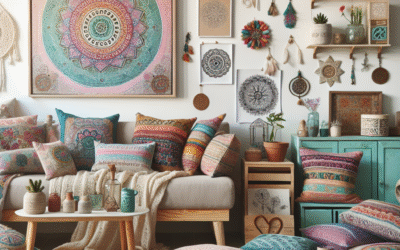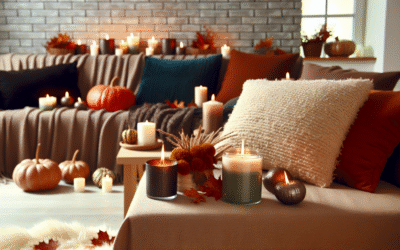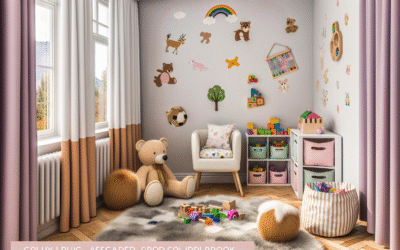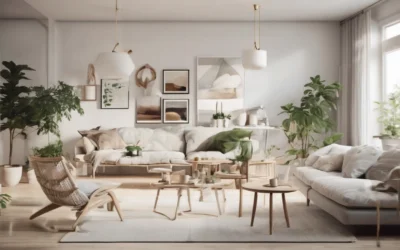
If you’ve ever felt overwhelmed by clutter and chaos, you’re not alone. In today’s fast-paced world, the yearning for simplicity and peace at home has never been stronger. Enter Japandi, a minimalist design style that beautifully combines the organic warmth of Japanese aesthetics with the functionality of Scandinavian design.
In this article, we’ll explore what defines Japandi interiors, the principles behind the merging of these two styles, and how to implement them in your own space. By the end of this read, you’ll feel empowered to create your own serene sanctuary.
What is Japandi Design?
Japandi design is a fusion of Japanese and Scandinavian aesthetics, representing minimalism, functionality, and natural beauty. This style accentuates simplicity, sharp lines, and earthy color palettes, creating a tranquil and cozy atmosphere.
The Roots of Japandi
The term ‘Japandi’ is a blend of Japanese and Scandinavian styles. Japanese design emphasizes harmony and tranquility, while Scandinavian design focuses on minimalism and functionality. Together, they promote a sense of peace and connection to nature.
Core Principles of Japandi Interiors
- Minimalism: Less is more. Every piece serves a purpose.
- Natural Materials: Wood, bamboo, and linen are primarily used to create warmth.
- Neutral Color Palette: Soft, earthy tones dominate.
- Functionality: Each element is functional but also pleasing to the eye.
- Zen Aesthetics: Create calm and serenity through design.
Creating Your Japandi Space
Transforming your home into a Japandi haven involves more than just choosing the right furniture. Here are some actionable steps you can take to curate your space.
Step 1: Declutter Your Space
Start by removing unnecessary items. Aim for a clean, open space where each item tells a story or has a function.
Step 2: Choose the Right Furniture
Opt for simple furniture pieces with clean lines that incorporate natural materials. Consider low-profile sofas or minimalist tables.
Step 3: Textures and Layers
Add layers with textiles—think light curtains, cozy throw blankets, and woven baskets to introduce comfort.
Step 4: Mindful Decor
Use decor that inspires peace—plants, artwork inspired by nature, or handcrafted items.
Step 5: Lighting to Enhance Ambiance
Select soft, warm lighting to enhance the calming atmosphere. Think lanterns, floor lamps, or wall sconces that fit the design theme.
Color Palettes in Japandi Design
Color plays a critical role in establishing the Japandi aesthetic. Below are some palettes to consider.
Earthy Tones
Use shades like beige, taupe, and olive green to create a harmonious environment.
Cool Neutrals
Soft greys and whites can amplify natural light and foster a sense of calm.
Accent Colors
Incorporate muted jewel tones for accent pieces to maintain a minimalist aesthetic.
Benefits of Japandi Interiors
Embracing Japandi design comes with several benefits:
Enhanced Well-being
Japandi’s sleek lines and serene palette promote emotional health and relaxation.
Increased Functionality
Spaces designed in this style are often more functional, as every piece serves a purpose.
Timeless Appeal
The minimalist essence of Japandi creates a timeless feel that won’t quickly go out of style.
Real-World Examples: Case Studies
Examining real-world implementations of Japandi can provide helpful insights:
Case Study 1: Modern Tokyo Apartment
A Tokyo residence incorporates sliding shoji screens, natural wood accents, and sparse decor to ensure both light and privacy, exemplifying the Japandi fusion.
Case Study 2: Scandinavian Loft
A Scandinavian loft embraces Japandi through its choice of muted colors, efficient furniture layout, and organic materials like wool and cotton.
Furniture and Decor Recommendations
To help you elevate your space, here are some furniture and decor suggestions:
Essential Furniture Pieces
- Low-profile sofas
- Simple wooden coffee tables
- Minimalist shelving units
Decor Items
- Handcrafted ceramics
- Plant pots made from terracotta
- Art prints inspired by nature
FAQs about Japandi Interiors
What are the main features of Japandi design?
Japandi design combines minimalism, functionality, and a focus on natural materials with a neutral color palette to create serene environments.
How can I incorporate Japandi style into a small space?
Utilize multifunctional furniture, declutter, and choose a light color palette to give the illusion of more space.
Is Japandi style suitable for all homes?
Yes! Japandi can be adapted to suit various spaces, emphasizing clean lines and functional elements to fit any home style.
Can I mix Japandi with other styles?
While Japandi embodies a unique aesthetic, it can harmoniously blend with other styles like bohemian or industrial with careful selection.
What role does color play in Japandi design?
Color in Japandi design typically consists of earthy tones and cool neutrals that evoke calmness and simplicity.
Conclusion and Next Steps
Transforming your home into a Japandi masterpiece is a journey worth embarking on. With principles of simplicity, functionality, and a deep connection to nature, you’ll create a space that nurtures well-being and style. Start decluttering today. Remember, every small change counts!
For more tips on home design and organization, check out our articles on Scandinavian Interiors and Minimalist Decor Ideas.
Content Disclaimer
The information provided here is for educational purposes only and does not constitute professional design or decor advice. Outcomes can vary based on individual circumstances.
Categories
- Accent Walls & Ceilings (61)
- Art Curation & Gallery (62)
- Bedding Style Trends (68)
- Bedroom Makeover (81)
- Bohemian & Eclectic Styles (58)
- DIY & Budget-Friendly Decor (64)
- Eco-Friendly Design (62)
- Furniture Care (71)
- Home Decor & Design Ideas (162)
- Home Wellness Spaces (59)
- Integrated Outdoor Living (67)
- Japandi Style (61)
- Kids and Nursery Decor (59)
- Living Room Decor (79)
- Mix & Match Techniques (73)
- Modern & Contemporary Design (66)
- Rug Sizing & Placement (73)
- Scandinavian Design Inspiration (20)
- Seasonal Home Decor (79)
- Small Space Solutions (73)
- Wall Art & Painting Tips (77)
Recent Comments
Archives
Product Gallery
-
Large Area Green Rugs for Bedroom Nordic Living Room Decoration Shaped Carpet Irregular Plush Lounge Rug Home Thick Washable Mat
Rated 5.00 out of 5$36.00 – $225.00Price range: $36.00 through $225.00 -
Nordic Style Rugs for Bedroom Morandi Living Room Decoration Carpet Large Area Geometry Lounge Rug Home Cloakroom Non-slip Mat
Rated 5.00 out of 5$26.00 – $387.00Price range: $26.00 through $387.00 -
Irregular Shapes Living Room Decoration Carpet Modern Style Rugs for Bedroom Home Thicken Plush Rug Fluffy Soft Lounge Floor Mat
Rated 4.83 out of 5$37.00 – $225.00Price range: $37.00 through $225.00














